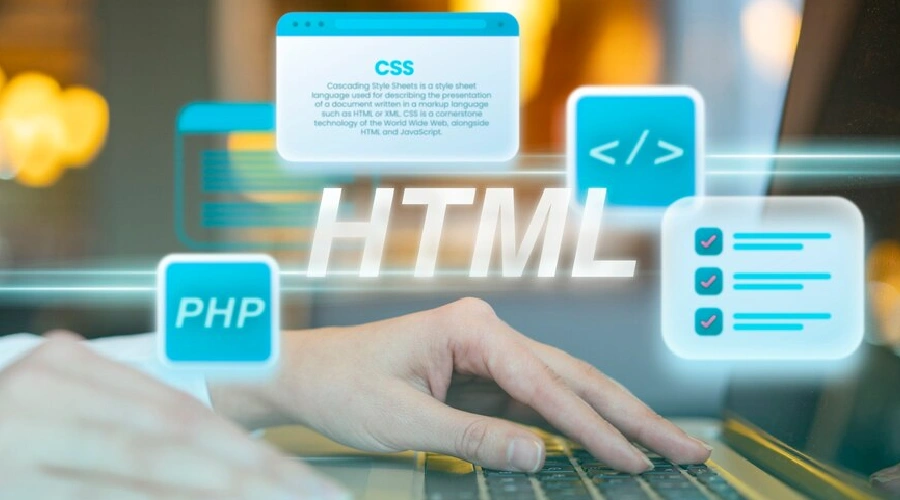Have you ever wondered how websites are made? Well, two important things come into play: HTML and PHP. Let’s break down what they are and how they’re different.
Table of Contents
HTML: Building the Structure
HTML, or Hypertext Markup Language, is like a web page’s blueprint. It decides how things look and where they go, such as headings, paragraphs, images, and links. HTML creates a webpage’s basic layout and determines how it appears to users.
The Role of HTML in Front-End Development
HTML plays a crucial role in front-end development, focusing on the presentation and structure of web pages. Front-end developers use HTML alongside CSS (Cascading Style Sheets) and JavaScript to create visually appealing and user-friendly interfaces. HTML provides the building blocks that CSS styles and JavaScript interactions enhance, resulting in engaging web experiences.
PHP: Making Things Happen
PHP, which stands for Hypertext Preprocessor, adds functionality to web pages. It’s like a magic spell that makes web pages do cool stuff. PHP can change web pages based on what you do, like filling out a form or clicking a button. It handles tasks like processing form data, accessing databases, and creating dynamic content.
Working Together: HTML and PHP Collaboration
While HTML focuses on structure and layout, PHP handles a webpage’s interactive and dynamic aspects. They often work together, with PHP code embedded within HTML files. This combination allows developers to create web pages that look good, respond to user actions, and display dynamic content.
| FEATURES | HTML | PHP |
| STANDS FOR | HYPERTEXT MARKUP LANGUAGE | HYPERTEXT PREPROCESSOR |
| Purpose | Defines structure and layout of web pages | Adds functionality and interactivity to web pages |
| Static or Dynamic | Static | Dynamic |
| File Extension | .html or .htm | .php |
| Processing | Client-side (browser) | The basic structure of web pages |
| Content | Defines elements like headings, paragraphs, images, links | Processes form data, accesses databases, generates dynamic content |
| Interaction | Limited user interaction | Allows user interaction and dynamic content generation |
| Usage | Basic structure of web pages | Handles backend operations and dynamic content |
| Example | <html></html>, <body></body> | <?php echo “Hello, World!”; ?> |
| Latest Updates | HTML5 introduced new semantic elements like <header>, <footer>, <nav>, <article>, etc. | PHP 8 introduced Union Types, Just-In-Time (JIT) compilation, and significant performance improvements. |
SEO Considerations: HTML Markup vs. Dynamic Content
Search engine optimization (SEO) is a critical aspect of web development, impacting the visibility and ranking of websites in search engine results. While HTML markup is inherently SEO-friendly, dynamic content generated by PHP requires careful optimization to ensure search engines can crawl and index it effectively. Developers must implement SEO best practices such as using semantic HTML tags, optimizing meta tags, and creating SEO-friendly URLs to maximize the visibility of PHP-generated content.
Error Handling and Debugging
Examine the approaches to error handling and debugging in HTML and PHP. While HTML errors are typically limited to syntax or markup issues that affect the layout or display of a webpage, PHP errors can range from syntax errors to runtime errors related to database connections or logic errors. Discuss techniques for debugging PHP code, such as error logging, using development environments, and utilizing debugging tools.
Accessibility and Usability: Ensuring a Positive User Experience
Accessibility and usability are essential considerations in web development, ensuring that websites are accessible to all users, including those with disabilities. HTML provides semantic markup that enhances accessibility, allowing screen readers and other assistive technologies to interpret and present content accurately. PHP developers must ensure that dynamically generated content maintains accessibility standards and provides a seamless user experience for all visitors.
In Conclusion
In conclusion, understanding the distinctions between HTML and PHP empowers developers to make informed decisions when building websites and web applications. By leveraging the strengths of each language and integrating them effectively, developers can create dynamic, interactive, and user-friendly web experiences that meet the needs of modern users. Whether you’re building a simple static webpage or a complex dynamic web application, HTML and PHP are powerful tools in your web development arsenal.

Your article helped me a lot, is there any more related content? Thanks!
I don’t think the title of your article matches the content lol. Just kidding, mainly because I had some doubts after reading the article.
Can you be more specific about the content of your article? After reading it, I still have some doubts. Hope you can help me.
Your point of view caught my eye and was very interesting. Thanks. I have a question for you.
Your point of view caught my eye and was very interesting. Thanks. I have a question for you.
I don’t think the title of your article matches the content lol. Just kidding, mainly because I had some doubts after reading the article.
Your article helped me a lot, is there any more related content? Thanks!